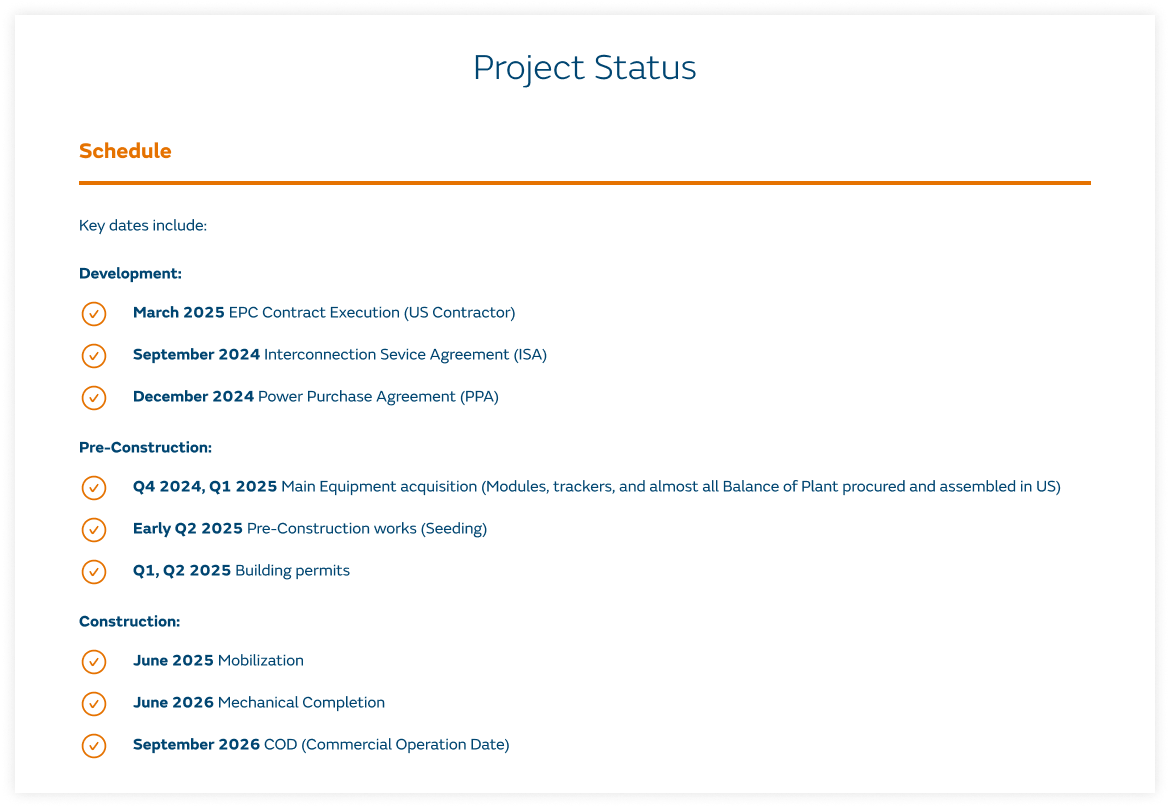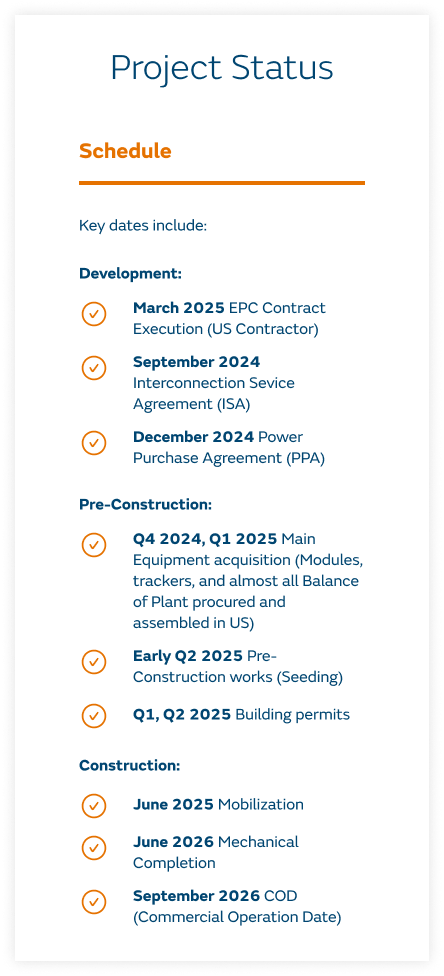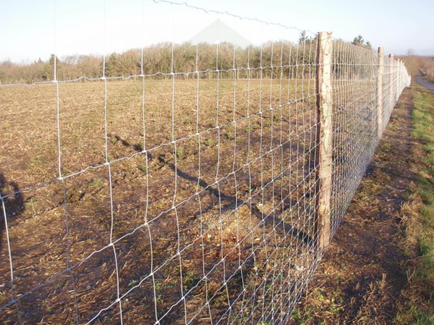Inicio / Mark Center Solar Project
Mark Center Solar Project
Overview
Mark Center Solar Project is a 90 MW AC photovoltaic solar facility, sited in Mark Township, Defiance County, Ohio. Developed by Naturgy, the project is designed to bring clean and renewable energy to the region with construction set to begin around 2025 and commercial operations targeted in 2026.
Mark Center Solar Project will help meet the energy needs of local homes and business by converting sunlight into electricity and delivering to the local electrical grid.
The facility is sited near Platter Creek Mark Center substation, operated by AEP, that is a key factor in selecting this location for the project. The substation’s existing infrastructure will ensure seamless integration of the energy produced by Mark Center into the broad power grid.
Community benefits
Mark Center Solar Project will bring substantial benefits to Mark Township community.
September 26
Targeted comercial operation date
69 kV
Interconnect
35 years
Project life
June 2025
Projected construction start
Around 220
220 construction jobs and 3 permanent jobs during lifespan
Additional benefits

Enhanced grid resilience by integrating renewable Energy.

Support for local business including suppliers, restaurants and service providers during construction.

Vegetation management, potential for agrovoltaics includding sheep grazing under the solar panels and pollinators, promoting soil health and sustainable land management practices.

Clean energry power supply for more than 20.000 homes.
Project status


FQAs
Mark Center Solar Project is an up to 90 MW solar facility located in Mark Township.
Construction is expected to begin in summer 2025, with comercial operation in 2026.
We expect the project to operate for 35 years. At the end of this period, the landowners will be able to return the land to traditional agriculture or other purposes as they wish.
Mark Center will create up to 220 constructions jobs with a preference for qualified local labor and create 2-3 permanent jobs. It will also generate substantial income for the Community in local tax revenue and enhance grid stability. Local business will also benefit from increased demand during the construction.
The project is designed to use available technologies to reduce grading and integrate sustainable practices like vegetation management and posible sheep grazing under the solar panels. The site will be seeded with native grasses and plans to integrate pollinator habitat.
Naturgy priorizes working closely with the local community, focusing on minimal environmental impact and sustainable development fostering strong relationships with the residents and the stakeholders.
No. For example, the net energy production per acre from solar is about 100 to 125 times greater than from corn-based ethanol. 1000 acres of corn ethanol can power roughly 700 cars for a year, while the same area with solar panels could power about 60,000 electric vehicles for a year.
Ethanol is one of the most widespread uses of farmland for energy production, with about 90 million acres of U.S. farmland planted in corn each year, and over one-third of that corn production is used to make ethanol, which is blended into gasoline and burned as fuel.
If ethanol is considered efficient enough to be a widely accepted energy source in our society, why shouldn’t solar.
Yes. The panels and other project equipment will be removed from Mark Center site at the end of the project´s life. This is a legally binding obligation that will be contained in the permits.
Yes, in fact this happened with the very first utility-scale solar power plan constructed in the US Arco Solar en 1982 on 117 acres of agricultural land near Santa Margarita, California. The Project was decomissioned in 1994, and the land returned to barley production for nearly 20 years. The land was developed for solar again as part of the Topaz Solar Farm starting in 2012.
Yes. Solar panels contain valuable materials, and the market for recycling these materials is booming. It is expected to be worth $2.7 billion by 2030. Solar panel recycling facilities already exist and are expanding rapidly – one notable example is Solarcycle’s new recycling plant in Odessa, Texas.
Solar projects passively convert sunlight into electricity, and are therefore effectively silent, except for the tracking motors and inverters that might produce an ambient hum that is typically inaudible beyond the project fence line.
No. The project will have strict measures in place to ensure that no construction activities impact the water table. As a passive technology, the operational project has minimal water requirements, so the project will not impact local well flow rates. The project is required by law to control stormwater and sediment runoff. In addition, the project will be re-vegetated after construction and use very little concrete, which reduces the volume and velocity of stormwater flow.
Like many other everyday products – including cell phones, computers, televisions, and cars, of which there are hundreds of thousands in Defiance County – solar panels do contain trace amounts of tin-based solder, silver, and other materials that in their pure forms can be dangerous. However, when combined with the glass, aluminum, plastic, copper, and semiconductor materials that make up most of the mass of a solar panel, these materials are stable, contained, and non-hazardous – just as they are in many everyday products. The EPA’s TCLP test is the accepted method for proving this. Mark Center Solar will be able to provide documentation that its panels pass the TCLP, proving that any leaching would remain within the same non-hazardous ranges required of any other non-hazardous product.
Operational solar panels produce no emissions, waste, odor, or byproducts. The extremely low frequency EMF from PV arrays and transmission lines is the same as the EMF people are exposed to from household electrical appliances and wiring in buildings.
Power from the project will flow onto the electric grid. Like water flowing to the lowest point, electricity generated by the project will serve local demand in the Defiance County area via interconnection into Platter Creek Mark r 69 kV substation.
Because solar panels generate energy by absorbing the sun’s rays, they are designed to reduce glare as much as possible. Additionally, because the trackers follow the sun through the day, most of the reflection that does occur will be directed back towards the sky rather than towards the ground or horizon.

Many species of small animals and birds quickly return to the arrays after construction. Solar arrays are proving to be popular foraging and breeding grounds for a diverse group of animals. Reduced grading will allow for the establishment of native grasses and other vegetation across the site, providing critical nesting and foraging habitat for wildlife. The project has been designed to maintain habitat connectivity by allowing wildlife to cross the project site, and will use agricultural-type fencing without barbed wire, specifically designed to be wildlife-friendly. This fencing allows smaller animals to pass freely beneath while guiding larger animals around the site, minimizing barriers to natural movement.
Solar projects do not raise ambient temperatures outside of the project boundary. The panels and surrounding air may get a few degrees hotter in the sun, but the effect is highly localized and will return to ambient temperatures at night with no sustained heat effect that is characteristic of “heat islands”.
Contact
